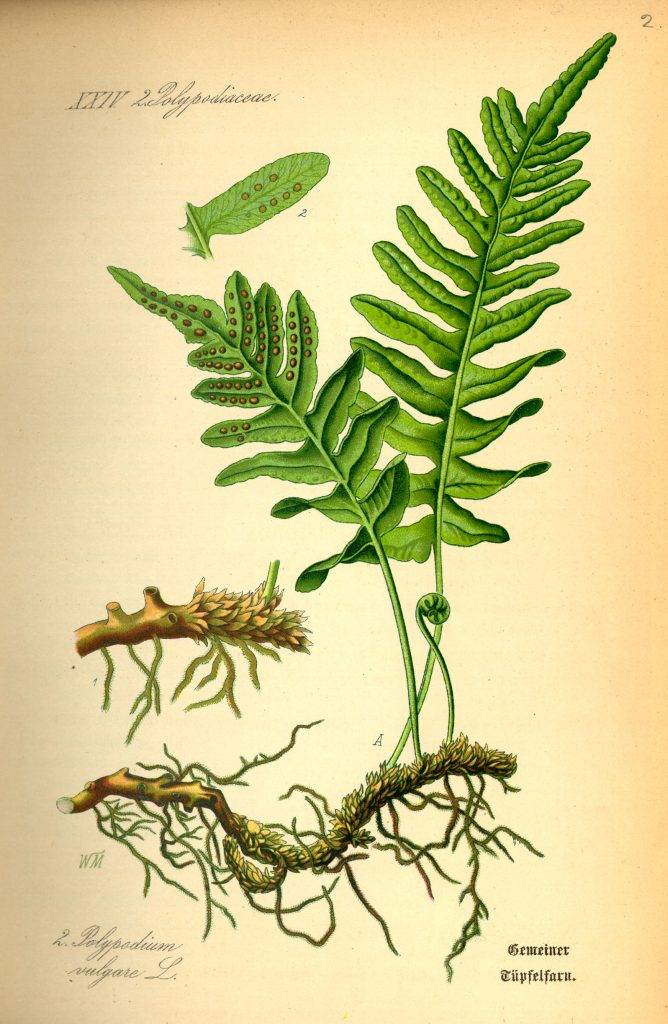
Sweet-root fern – Polypodium vulgare
Sweet-root fern (Polypodium polypodium):
Polypodium vulgare (Old or other known names: angel’s-wort, woodland fern, hollyhock, hollyhock fern, hollyhock, devil’s-side-root, holy-holy-root) Ferns – Polypodiaceae The sweet-root fern is a perennial plant with a creeping, cupped, brown-scaled stem and a rhizome ( rhizoma polypodii). This capital is commonly, though incorrectly, called the root(radix polypodii). The upper side gives rise to the two rows of upright leaves, while the lower side gives rise to the fibrous roots that attach to the ground. Its leaves are long-tongued, thick and leathery, because they are green even in winter. The leaf plate is simply winged. The winged margins are blunt-tipped and alternate along the leaf spine; they are connected to each other along the leaf spine by the leaf plate, since the notches do not extend all the way to the leaf spine. The leaf cymes become smaller towards the tip of the leaf, so that the leaf tip has only a shallowly lobed edge. On the backbone of the leaf are the brownish, rounded fruit clusters, the so-called sporocarps, which are nothing more than dense clusters of spore-holder. These fruit clusters are arranged in two or two rows along the veins of the leaf lobes and are stamens in the summer months, when the spore dust is released. The spores are fine powdery cells which serve for the reproduction of the fern. These spores germinate on wet soil. The leaves are 15-30 cm long. The sweet-root fern is green all year round, its spores ripening in summer.
Occurrence:
The sweet-root fern is native throughout our country (unfortunately, this is no longer true, but it was true in 1906), is widespread in the shady mountain forests and reaches up to the lowlands. It is found mostly on shady cliffs, on the stone walls of old castles, in the stony, shady places of forests, on old tree stumps, in gorges, on the damp, gravelly cliffs of the forest. It also grows in good forest soil and likes lime soil. Currently found in the Gödöllő hills.
Medicinal properties of the sweet-root fern:
Sweet-root fern has a sweet at first, then slightly bitterish and astringent, unpleasant, stimulating taste and an acrid smell. When dried and cleaned of scales, it is traded under the more correct names of rhizoma polypodii or radix polypodii and filiculae dulcis. Licorice is commonly used instead of true liquorice to treat mastitis. When boiled it has a weak propellant property. When taken against coughs and hoarseness it has a solvent effect, which is why it is used as a chest tea. It is also used against gout, jaundice and fever, and to ward off worms. It contains sugars, easily acidified fatty oil, resin and tannins. Active ingredients: Glycyrrhizin, sugar, fatty oil, malic acid and tanning agent. Ingestion: The root can be harvested in spring or autumn. You can start harvesting in September. The cleaned rootstock should be cleaned of leaves, root parts and the brown scales that cover it densely, The cleaned rootstock is thin, curved, slightly flattened, reddish brown in colour, easily broken when dry, with a greenish yellow or brownish fracture and a watery sheen. The cleaned roots should be dried on a tarpaulin in a shady place and, when completely dry, can be transported in bags, 5 kg of fresh roots will yield 3 kg of dry roots. Source: Béla Páter, The wild herbs Dr. Ferenc Darvas and Dr Gyula Magyary-Kossa, Domestic medicinal plants, their production, marketing, effects and medicinal uses.
